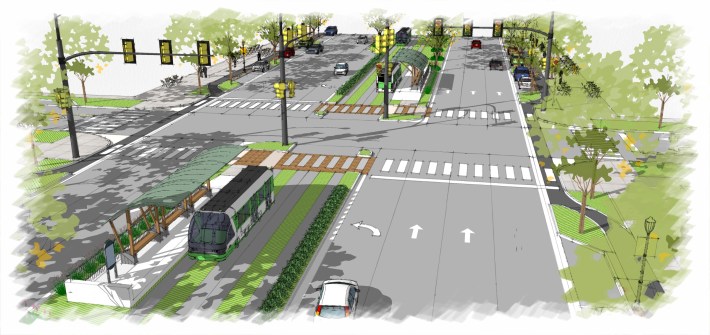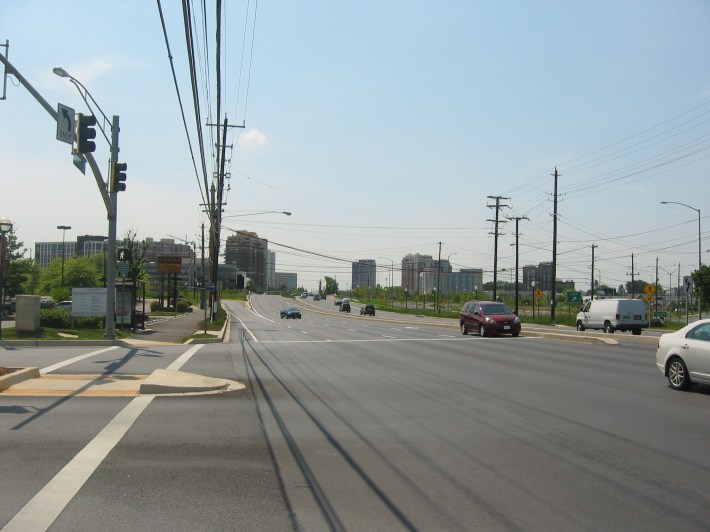How Value Capture Financing Will Revitalize White Flint
3:58 PM EDT on October 20, 2011
White Flint, Maryland, a suburb of Washington, DC, should be a shining example of transit-oriented development. It’s centered on a metro station on the busy red line, sandwiched between the bustling suburban downtowns of Bethesda and Rockville.

But instead, it’s “sprawling suburbia,” covered in surface parking lots and lacking a true road network. “Community members say they're within spitting distance of White Flint Mall but they have to drive to get there because of the road network,” says developer Francine Waters, who manages the transportation and smart growth program at Lerner Enterprises.
Seeing the wasted potential of the area, Lerner and five other developers that own much of the land in White Flint came together to figure out how to make Rockville Pike, White Flint’s main artery, a destination and not just a thoroughfare. Waters told the story this week at Rail~Volution to an audience eager to learn how public-private partnerships and value capture strategies could work in their neck of the woods.
Not only are the White Flint developers looking to include more mixed-use development in the community, they want to build new local streets to fill in a viable street grid and redesign the eight-lane Rockville Pike into a “21st century boulevard” with wide sidewalks, bike lanes, six rows of trees, and dedicated transit lanes. They want to fill those lanes with bus rapid transit to take short-haul commuters off of the at-capacity red line.
The infrastructure total is estimated to cost $601 million – and the federal government isn’t picking up a dime of it.
White Flint is at the forefront of a new kind of infrastructure financing – one which involves the private sector more than the government. As federal funds dry up, all eyes have turned to public-private partnerships, but the topic is still often the subject of much head-scratching and hand-wringing in Congress. Indeed, some have rung the alarm bell about over-reliance on the private sector when it comes to building high-speed rail, saying the public often bears too much of the risk while the private developers carry off all the profit.
Through an extended series of community consultations, White Flint’s developers appear to have gained the public's trust, and now they're charging forward with ambitious plans to remake an auto-centric suburban sprawl zone. And by bypassing federal aid, they’re also bypassing the reams of paperwork and bureaucratic processes that come with it, which often add years and millions of dollars to total project cost.
The developers are taking most of the money out of their own hide – paying $280 million for infrastructure improvements, including street-building, on their own individual properties, as well as $169 million that they’ll pay through a development district tax. The remaining $152 million for public roads, schools, and community centers will come from the county.
The developers, of course, are not rebuilding White Flint out of some higher civic-minded purpose. They’re doing it in exchange for higher density caps and to add value to their holdings. But they’re willing to pay upfront to bring that change.
There are many other ways to craft public-private partnerships, also known as PPPs or P3s. Around the Washington area, especially, sometimes it’s as simple as a government agency agreeing to be a tenant in a new building, filling the building with a guaranteed number of office employees. Or sometimes all the government needs to do is help out with some “pre-development” money – laying out money for project assessments when the future is still too uncertain for developers to want to spend any of their own money.
New Jersey developer Chris Kane said a recent major redevelopment at the Hudson-Bergen light rail station in Jersey City was done “the old way” – through state and federal grants – “so there was no pressure at the time to get beneficiaries contributing to the project.” The result: Tremendous value was added to real estate holdings, but none of that value was used to fund the project. And it’ll be harder to get stakeholders to contribute later on to maintenance or operations costs if needed.
“Value capture” is defined by Ian Carlton of TransACT as “the process by which all or a portion of increments in land value attributed to ‘community interventions’ – rather than landowner actions – are recouped by the public sector.”
Often, all that’s needed to get developer buy-in is a promise that they can double their density. Much of the explosive re-generation of Tyson’s Corner, Virginia, is made possible by developers tempted by newly unrestricted density near metro stations.
But there are lots of ways to capture value. Portland led the way, financing its streetcar system primarily with value capture strategies. They created two assessment districts, meaning that landowners near the proposed streetcar line paid extra taxes to help fund the transit because it would add value to their properties. The city also levied parking fees to help pay for it.
Washington, DC’s Metro agency has also been successful at implementing value capture, which currently covers about 0.7 percent of its annual budget.
The most common value capture strategy is joint development, meaning a transit agency collaborates with a private company to develop land or buildings the agency owns. About 60 percent of transit agencies say they’ve used it, compared with just 11 percent that have used tax increment financing, for example, which captures projected increases in tax revenue to fund the project.
In other cases, like White Flint, developers and local governments can use a process of “negotiated exaction” to determine what private holdings will be developed as part of the public commodity – to build new station-area parking or access roads, for example.
Carlton of TransACT said impact fees can be a form of value capture too. An impact fee is levied, for example, in greenfield development, when the new housing a developer wants to build would create more traffic. In that case, the developer sometimes helps pay for a new road to be built. Of course, rather than mitigate the impact of the new housing, this kind of building usually just creates more sprawl and more congestion.
In one case, developers wanted to redevelop a 600-acre abandoned railyard near National Airport, just outside of DC. They couldn’t get a permit, said Rick Rybeck of consulting firm Just Economics, because traffic on Route 1 is already maxed out during rush hour. But, local officials said, the yellow and blue metro lines run right through the property. If there were a station there, officials said, they’d consider it.
The developers, according to Rybeck, decided it was worth it to pay 100 percent of the cost of a new transit station at the lot, allowing them to develop the site without exacerbating traffic.
Unfortunately, citizens were too afraid of the prospect of increased density to appreciate the added amenities the development and transit access would bring, and they forced the lot to be down-zoned for lower density. Once the area was down-zoned, it would no longer be profitable enough for the developers, and they ended up abandoning the project.
Without value capture, the city or county may at some point build the new road or transit station, but the landowners will simply wait until the new road is built, which increases the value of the land, to develop it. In that way, they’ve benefited from the public investment without contributing to it.
Value capture helps transit agencies realize the potential of TOD. Without it, the temptation to build transit in lower value areas might be too great. But with enthusiastic buy-in – and funding – from nearby landowners, agencies can be persuaded to build transit where it’s needed, in the center of urban activity.
Nadine Fogarty of Strategic Economics said the best predictor of successful development is finding sites where the value of the land underneath a building is high relative to what’s on top if it. If you get rid of the building and build something new, you’ll get a big bang for your buck. That’s the sort of opportunity that developers are looking for, and that’s the sort of value increase transit can create.
Stay in touch
Sign up for our free newsletter
More from Streetsblog USA
Friday’s Headlines Got Served
Another day, another GOP lawsuit trying to overturn a Biden administration climate change rule.
Disabled People Are Dying in America’s Crosswalks — But We’re Not Counting Them
The data on traffic fatalities and injuries doesn’t account for their needs or even count them. Better data would enable better solutions.
LA: Automated Enforcement Coming Soon to a Bus Lane Near You
Metro is already installing on-bus cameras. Soon comes testing, outreach, then warning tickets. Wilshire/5th/6th and La Brea will be the first bus routes in the bus lane enforcement program.
Talking Headways Podcast: Charging Up Transportation
This week, we talk to the great Gabe Klein, executive director of President Biden's Joint Office of Energy and Transportation (and a former Streetsblog board member), about curbside electrification.
Why Does the Vision Zero Movement Stop At the Edge of the Road?
U.S. car crash deaths are nearly 10 percent higher if you count collisions that happen just outside the right of way. So why don't off-road deaths get more air time among advocates?





